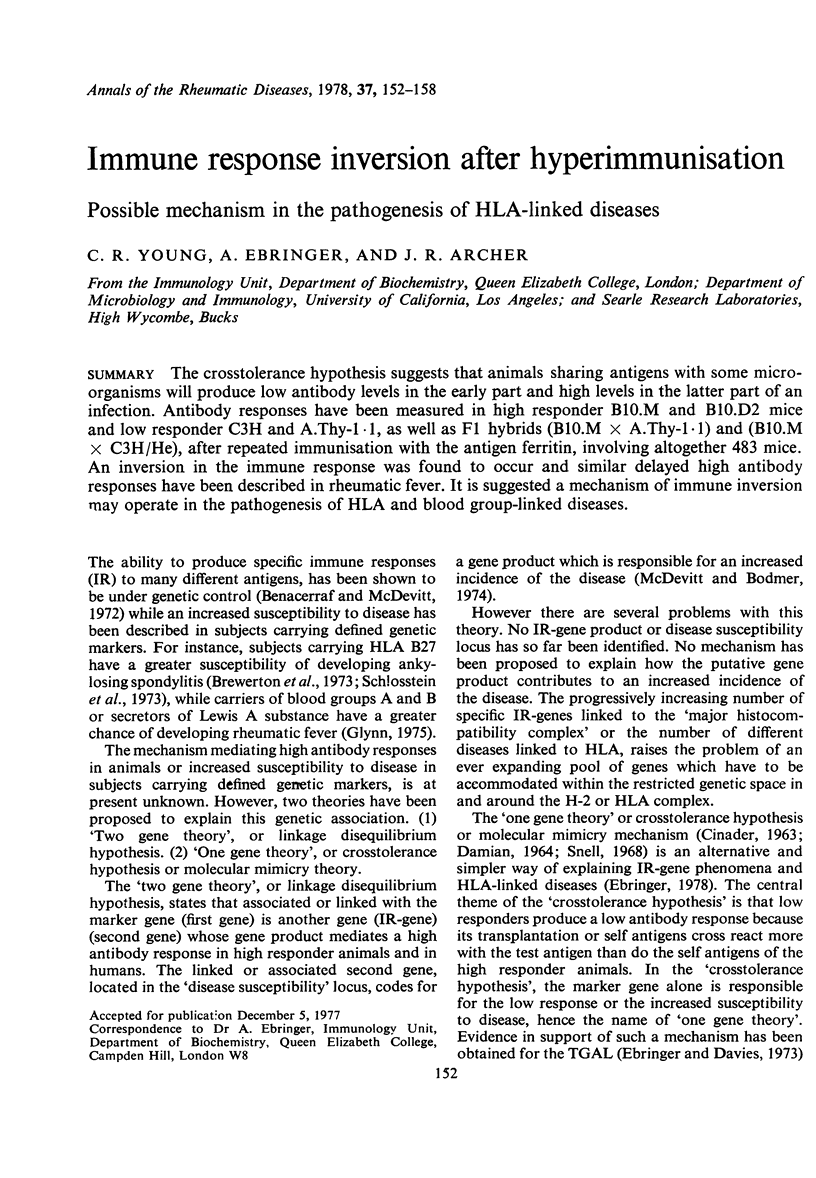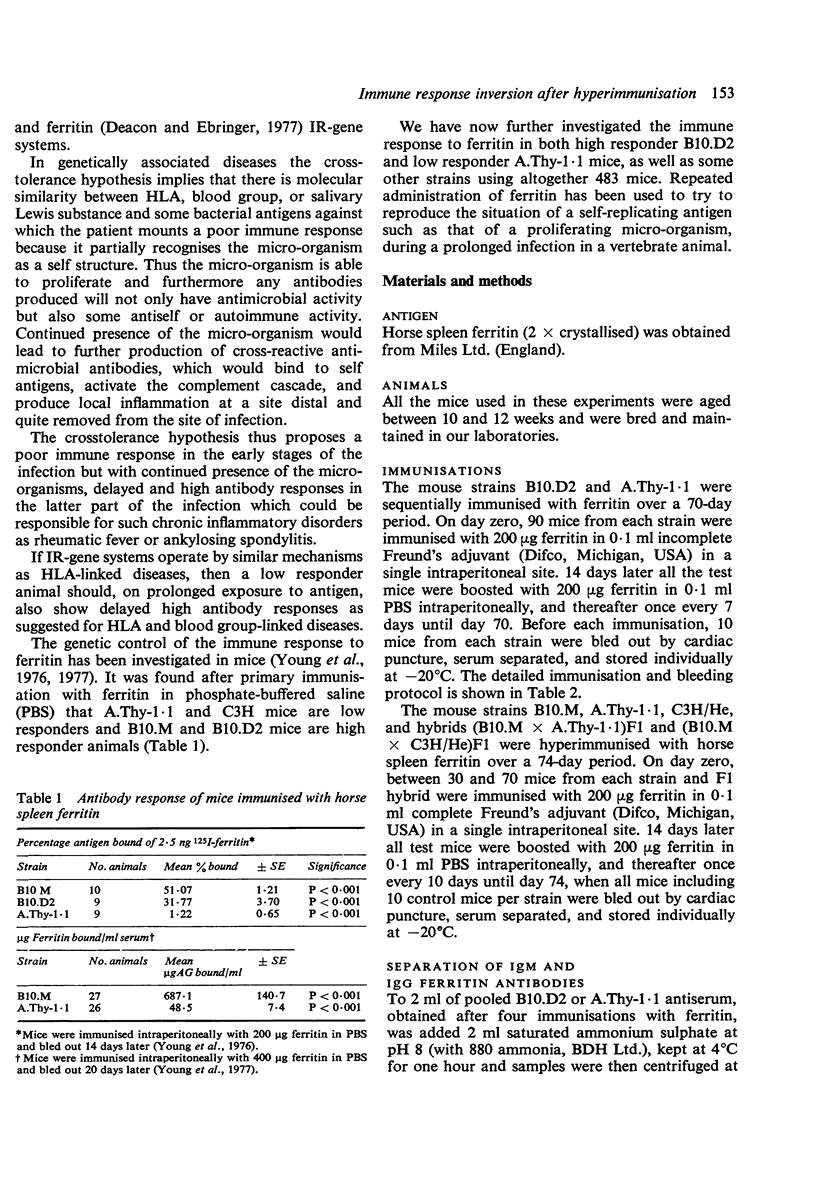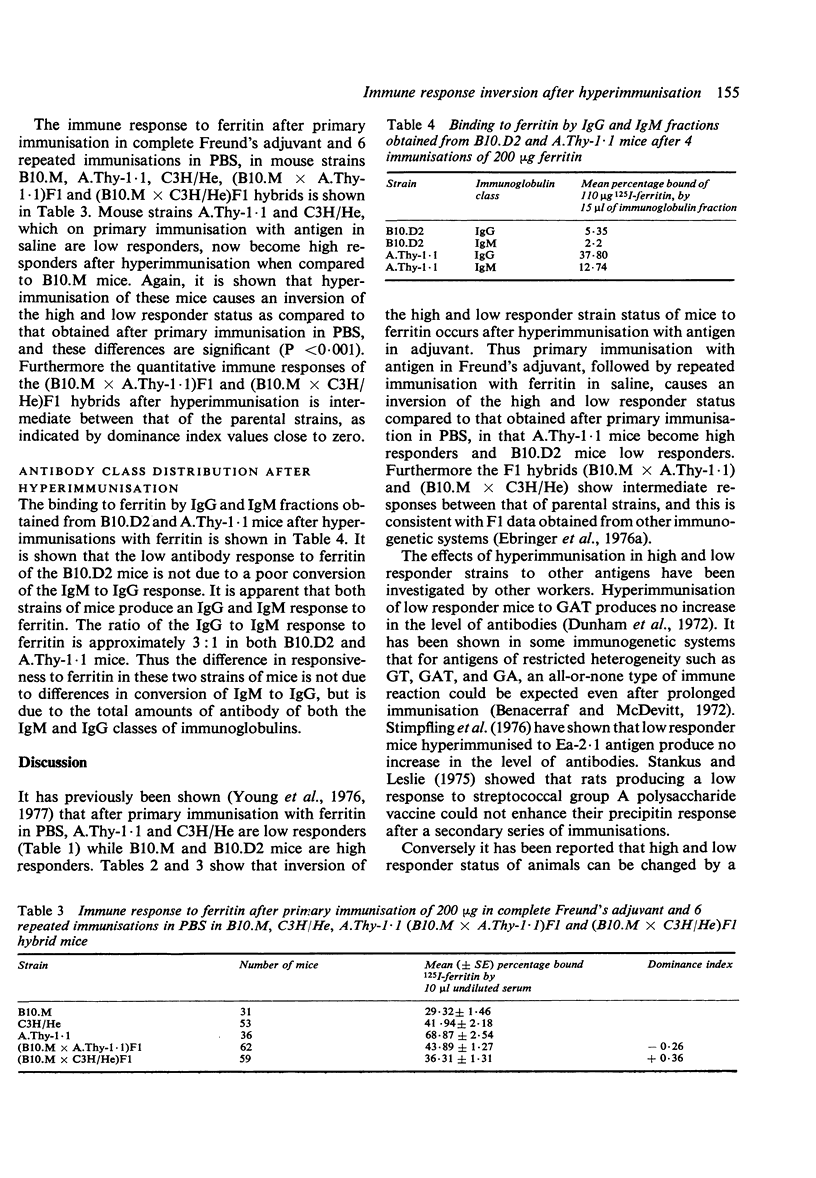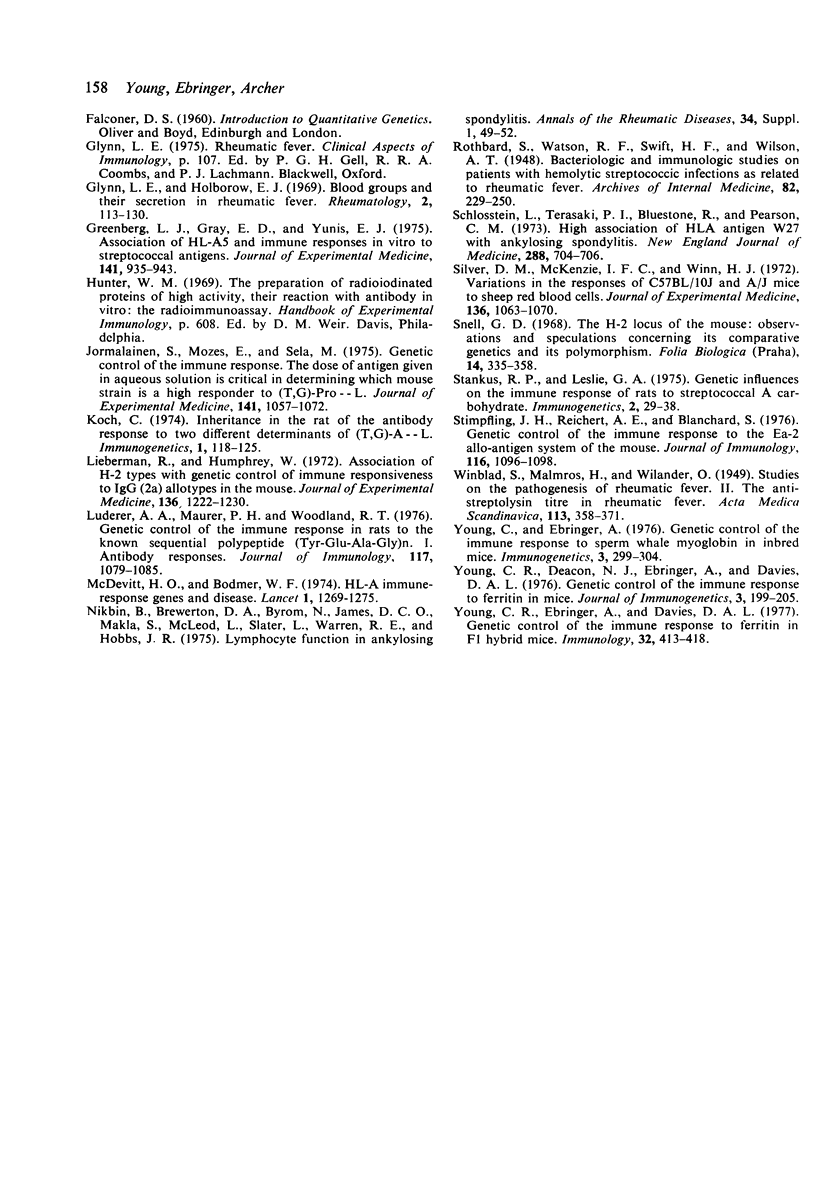Abstract
The crosstolerance hypothesis suggests that animals sharing antigens with some microorganisms will produce low antibody levels in the early part and high levels in the latter part of an infection. Antibody responses have been measured in high responder B10.M and B10.D2 mice and low responder C3H and A.Thy-1.1, as well as F1 hybrids (B10.M X A.Thy-1.1) and (B10.M X C3H/He), after repeated immunisation with the antigen ferritin, involving altogether 483 mice. An inversion in the immune response was found to occur and similar delayed high antibody responses have been described in rheumatic fever. It is suggested a mechanism of immune inversion may operate in the pathogenesis of HLA and blood group-linked diseases.
Full text
PDF






Selected References
These references are in PubMed. This may not be the complete list of references from this article.
- Benacerraf B., McDevitt H. O. Histocompatibility-linked immune response genes. Science. 1972 Jan 21;175(4019):273–279. doi: 10.1126/science.175.4019.273. [DOI] [PubMed] [Google Scholar]
- Brewerton D. A., Hart F. D., Nicholls A., Caffrey M., James D. C., Sturrock R. D. Ankylosing spondylitis and HL-A 27. Lancet. 1973 Apr 28;1(7809):904–907. doi: 10.1016/s0140-6736(73)91360-3. [DOI] [PubMed] [Google Scholar]
- CINADER B. DEPENDENCE OF ANTIBODY RESPONSES ON STRUCTURE AND POLYMORPHISM OF AUTOLOGOUS MACROMOLECULES. Br Med Bull. 1963 Sep;19:219–224. doi: 10.1093/oxfordjournals.bmb.a070060. [DOI] [PubMed] [Google Scholar]
- Deacon N. J., Ebringer A. Cross-reactivity in the radioimmunoassay of ferritin with cells from high- and low-responder mice. Biochem Soc Trans. 1977;5(1):256–258. doi: 10.1042/bst0050256. [DOI] [PubMed] [Google Scholar]
- Dixon F. J., Jacot-Guillarmod H., McConahey P. J. The antibody responses of rabbits and rats to hemocyanin. J Immunol. 1966 Sep;97(3):350–355. [PubMed] [Google Scholar]
- Dunham E. K., Unanue E. R., Benacerraf B. Antigen binding and capping by lymphocytes of genetic nonresponder mice. J Exp Med. 1972 Aug 1;136(2):403–408. doi: 10.1084/jem.136.2.403. [DOI] [PMC free article] [PubMed] [Google Scholar]
- Ebringer A., Davies D. A. Gross reactivity between synthetic T,GA-L and transplantation antigens in CBA Mice. Nat New Biol. 1973 Jan 31;241(109):144–147. doi: 10.1038/newbio241144a0. [DOI] [PubMed] [Google Scholar]
- Ebringer A., Deacon N. J., Young C. R. Codominant inheritance in immunogenetic (IR-gene) systems. J Immunogenet. 1976 Dec;3(6):401–409. doi: 10.1111/j.1744-313x.1976.tb00602.x. [DOI] [PubMed] [Google Scholar]
- Ebringer R., Cooke D., Cawdell D. R., Cowling P., Ebringer A. Ankylosing spondylitis: klebsiella and HL-A B27. Rheumatol Rehabil. 1977 Aug;16(3):190–196. doi: 10.1093/rheumatology/16.3.190. [DOI] [PubMed] [Google Scholar]
- Eichmann K. Idiotypic identity of antibodies to streptococcal carbohydrate in inbred mice. Eur J Immunol. 1972 Aug;2(4):301–307. doi: 10.1002/eji.1830020402. [DOI] [PubMed] [Google Scholar]
- Glynn L. E., Holborow E. J. Blood groups and their secretion in rheumatic fever. Rheumatology. 1969;2:113–130. [PubMed] [Google Scholar]
- Greenberg L. J., Gray E. D., Yunis E. J. Association of HL-A 5 and immune responsiveness in vitro to streptococcal antigens. J Exp Med. 1975 May 1;141(5):935–943. doi: 10.1084/jem.141.5.935. [DOI] [PMC free article] [PubMed] [Google Scholar]
- Jormalainen S., Mozes E., Sela M. Genetic control of immune response. The dose of antigen given in aqueous solution is critical in determining which mouse strain is high responder to poly(LTyr, LGlu)-poly(LPro)--poly(LLys). J Exp Med. 1975 May 1;141(5):1057–1072. doi: 10.1084/jem.141.5.1057. [DOI] [PMC free article] [PubMed] [Google Scholar]
- Lieberman R., Humphrey W., Jr Association of H-2 types with genetic control of immune reponsiveness to IgG (gamma2a) allotypes in the mouse. J Exp Med. 1972 Nov 1;136(5):1222–1230. doi: 10.1084/jem.136.5.1222. [DOI] [PMC free article] [PubMed] [Google Scholar]
- Luderer A. A., Maurer P. H., Woodland R. T. Genetic control of the immune response in rats to the known sequential polypeptide (Tyr-Glu-Ala-Gly)n. I. Antibody responses. J Immunol. 1976 Oct;117(4):1079–1084. [PubMed] [Google Scholar]
- McDevitt H. O., Bodmer W. F. HL-A, immune-response genes, and disease. Lancet. 1974 Jun 22;1(7869):1269–1275. doi: 10.1016/s0140-6736(74)90021-x. [DOI] [PubMed] [Google Scholar]
- Schlosstein L., Terasaki P. I., Bluestone R., Pearson C. M. High association of an HL-A antigen, W27, with ankylosing spondylitis. N Engl J Med. 1973 Apr 5;288(14):704–706. doi: 10.1056/NEJM197304052881403. [DOI] [PubMed] [Google Scholar]
- Silver D. M., McKenzie I. F., Winn H. J. Variations in the responses of C57BL-10J and A-J mice to sheep red blood cells. J Exp Med. 1972 Nov 1;136(5):1063–1071. doi: 10.1084/jem.136.5.1063. [DOI] [PMC free article] [PubMed] [Google Scholar]
- Snell G. D. The H-2 locus of the mouse: observations and speculations concerning its comparative genetics and its polymorphism. Folia Biol (Praha) 1968;14(5):335–358. [PubMed] [Google Scholar]
- Stimpfling J. H., Reichert A. E., Blanchard S. Gentic control of the immune response to the Ea-2 alloantigen system of the mouse. I. The humoral antibody response. J Immunol. 1976 Apr;116(4):1096–1098. [PubMed] [Google Scholar]
- Young C. R., Deacon N. J., Ebringer A., Davies D. A. Genetic control of the immune response to ferritin in mice. J Immunogenet. 1976 Jun;3(3):199–205. doi: 10.1111/j.1744-313x.1976.tb00573.x. [DOI] [PubMed] [Google Scholar]
- Young C. R., Ebringer A., Davies D. A. Genetic control of the immune response to ferritin in F1 hybrid mice. Immunology. 1977 Apr;32(4):413–418. [PMC free article] [PubMed] [Google Scholar]


